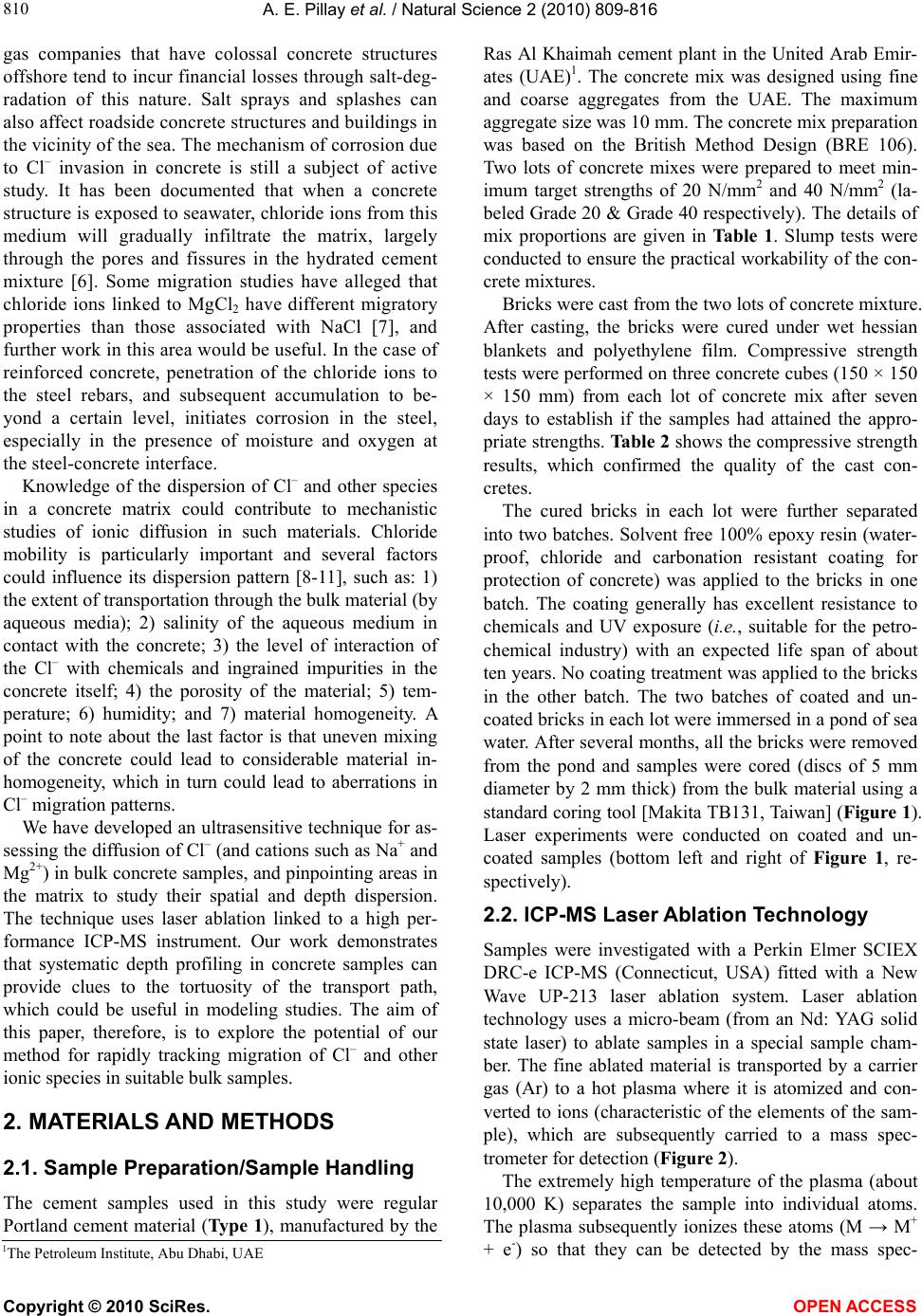
A. E. Pillay et al. / Natural Science 2 (2010) 809-816
Copyright © 2010 SciRes. OPEN ACCESS
810
gas companies that have colossal concrete structures
offshore tend to incur financial losses through salt-deg-
radation of this nature. Salt sprays and splashes can
also affect roadside concrete structures and buildings in
the vicinity of the sea. The mechanism of corrosion due
to Cl– invasion in concrete is still a subject of active
study. It has been documented that when a concrete
structure is exposed to seawater, chloride ions from this
medium will gradually infiltrate the matrix, largely
through the pores and fissures in the hydrated cement
mixture [6]. Some migration studies have alleged that
chloride ions linked to MgCl2 have different migratory
properties than those associated with NaCl [7], and
further work in this area would be useful. In the case of
reinforced concrete, penetration of the chloride ions to
the steel rebars, and subsequent accumulation to be-
yond a certain level, initiates corrosion in the steel,
especially in the presence of moisture and oxygen at
the steel-concrete interface.
Knowledge of the dispersion of Cl– and other species
in a concrete matrix could contribute to mechanistic
studies of ionic diffusion in such materials. Chloride
mobility is particularly important and several factors
could influence its dispersion pattern [8-11], such as: 1)
the extent of transportation through the bulk material (by
aqueous media); 2) salinity of the aqueous medium in
contact with the concrete; 3) the level of interaction of
the Cl– with chemicals and ingrained impurities in the
concrete itself; 4) the porosity of the material; 5) tem-
perature; 6) humidity; and 7) material homogeneity. A
point to note about the last factor is that uneven mixing
of the concrete could lead to considerable material in-
homogeneity, which in turn could lead to aberrations in
Cl– migration patterns.
We have developed an ultrasensitive technique for as-
sessing the diffusion of Cl– (and cations such as Na+ and
Mg2+) in bulk concrete samples, and pinpointing areas in
the matrix to study their spatial and depth dispersion.
The technique uses laser ablation linked to a high per-
formance ICP-MS instrument. Our work demonstrates
that systematic depth profiling in concrete samples can
provide clues to the tortuosity of the transport path,
which could be useful in modeling studies. The aim of
this paper, therefore, is to explore the potential of our
method for rapidly tracking migration of Cl– and other
ionic species in suitable bulk samples.
2. MATERIALS AND METHODS
2.1. Sample Preparation/Sample Handling
The cement samples used in this study were regular
Portland cement material (Type 1), manufactured by the
Ras Al Khaimah cement plant in the United Arab Emir-
ates (UAE)1. The concrete mix was designed using fine
and coarse aggregates from the UAE. The maximum
aggregate size was 10 mm. The concrete mix preparation
was based on the British Method Design (BRE 106).
Two lots of concrete mixes were prepared to meet min-
imum target strengths of 20 N/mm2 and 40 N/mm2 (la-
beled Grade 20 & Grade 40 respectively). The details of
mix proportions are given in Table 1. Slump tests were
conducted to ensure the practical workability of the con-
crete mixtures.
Bricks were cast from the two lots of concrete mixture.
After casting, the bricks were cured under wet hessian
blankets and polyethylene film. Compressive strength
tests were performed on three concrete cubes (150 × 150
× 150 mm) from each lot of concrete mix after seven
days to establish if the samples had attained the appro-
priate strengths. Table 2 shows the compressive strength
results, which confirmed the quality of the cast con-
cretes.
The cured bricks in each lot were further separated
into two batches. Solvent free 100% epoxy resin (water-
proof, chloride and carbonation resistant coating for
protection of concrete) was applied to the bricks in one
batch. The coating generally has excellent resistance to
chemicals and UV exposure (i.e., suitable for the petro-
chemical industry) with an expected life span of about
ten years. No coating treatment was applied to the bricks
in the other batch. The two batches of coated and un-
coated bricks in each lot were immersed in a pond of sea
water. After several months, all the bricks were removed
from the pond and samples were cored (discs of 5 mm
diameter by 2 mm thick) from the bulk material using a
standard coring tool [Makita TB131, Taiwan] (Figure 1).
Laser experiments were conducted on coated and un-
coated samples (bottom left and right of Figure 1, re-
spectively).
2.2. ICP-MS Laser Ablation Technology
Samples were investigated with a Perkin Elmer SCIEX
DRC-e ICP-MS (Connecticut, USA) fitted with a New
Wave UP-213 laser ablation system. Laser ablation
technology uses a micro-beam (from an Nd: YAG solid
state laser) to ablate samples in a special sample cham-
ber. The fine ablated material is transported by a carrier
gas (Ar) to a hot plasma where it is atomized and con-
verted to ions (characteristic of the elements of the sam-
ple), which are subsequently carried to a mass spec-
trometer for detection (Figure 2).
The extremely high temperature of the plasma (about
10,000 K) separates the sample into individual atoms.
The plasma subsequently ionizes these atoms (M → M+
+ e-) so that they can be detected by the mass spec-
1The Petroleum Institute, Abu Dhabi, UAE